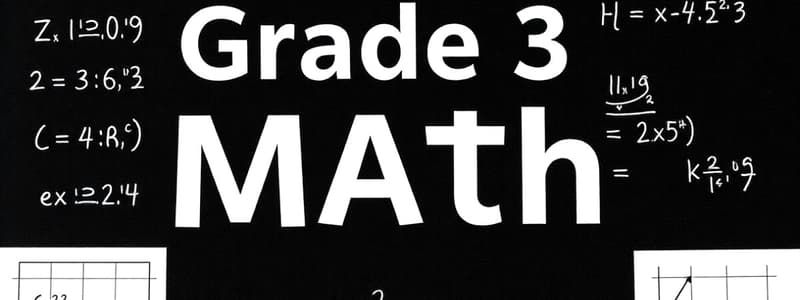Podcast
Questions and Answers
Which item has the highest value in the data analysis?
Which item has the highest value in the data analysis?
- Item C (correct)
- Item D
- Item B
- Item A
What could be a reason for 'careless error' in error analysis?
What could be a reason for 'careless error' in error analysis?
- Not understanding the concepts
- Not checking work properly (correct)
- Incorrect use of formulas
- Rushed through problems
Which mathematical skill is directly referenced for composing and decomposing numbers?
Which mathematical skill is directly referenced for composing and decomposing numbers?
- Calculating averages
- Addition and subtraction
- Multiplication and division
- Using expanded notation (correct)
What is one reason why students might 'stop too early' in error analysis?
What is one reason why students might 'stop too early' in error analysis?
How many total errors were recorded in the analysis provided?
How many total errors were recorded in the analysis provided?
What is the maximum number allowed for composing and decomposing according to the instructional implications?
What is the maximum number allowed for composing and decomposing according to the instructional implications?
What instructional implication can be drawn from learning from mistakes?
What instructional implication can be drawn from learning from mistakes?
Which of the following methods is not included for composing and decomposing numbers?
Which of the following methods is not included for composing and decomposing numbers?
Which option represents a core concept studied in the cluster comparison of whole numbers?
Which option represents a core concept studied in the cluster comparison of whole numbers?
In error analysis, what might 'mixed up concepts' indicate?
In error analysis, what might 'mixed up concepts' indicate?
Which numeric representation helps in understanding place value when working with numbers up to 100,000?
Which numeric representation helps in understanding place value when working with numbers up to 100,000?
In the context of the assessment data provided, which item scored the highest?
In the context of the assessment data provided, which item scored the highest?
What aspect of number representation is highlighted by the content's instructional implications?
What aspect of number representation is highlighted by the content's instructional implications?
What does the analysis of assessed standards primarily aim to address?
What does the analysis of assessed standards primarily aim to address?
Which of the following statements about number decomposition is true?
Which of the following statements about number decomposition is true?
What instructional standard is referenced regarding the representation of whole numbers?
What instructional standard is referenced regarding the representation of whole numbers?
What does standard 3.2(A) focus on in numerical understanding?
What does standard 3.2(A) focus on in numerical understanding?
Which method is not mentioned as suitable for representing numbers in standard 3.2(A)?
Which method is not mentioned as suitable for representing numbers in standard 3.2(A)?
What type of errors might learners encounter when working with number decomposition?
What type of errors might learners encounter when working with number decomposition?
Which of the following concepts is a significant aspect of the instructional implications derived from mixed up concepts?
Which of the following concepts is a significant aspect of the instructional implications derived from mixed up concepts?
Why is it beneficial to understand the process of numbers up to 100,000?
Why is it beneficial to understand the process of numbers up to 100,000?
The assessment standards related to number representation primarily aid in developing which fundamental skill?
The assessment standards related to number representation primarily aid in developing which fundamental skill?
Identifying errors in number decomposition can lead to what educational approach?
Identifying errors in number decomposition can lead to what educational approach?
When analyzing standards, what is crucial to achieving a comprehensive understanding of whole numbers?
When analyzing standards, what is crucial to achieving a comprehensive understanding of whole numbers?
Which number correctly represents two ten thousands, three thousands, eight hundreds, and one ten?
Which number correctly represents two ten thousands, three thousands, eight hundreds, and one ten?
What is the decomposed form of the number 54,321?
What is the decomposed form of the number 54,321?
Which of these processes involves using objects or pictorial models to represent numbers up to 100,000?
Which of these processes involves using objects or pictorial models to represent numbers up to 100,000?
If a student wrote the number as 90 + 7,700 + 30,000 + 4,000, what number were they trying to express?
If a student wrote the number as 90 + 7,700 + 30,000 + 4,000, what number were they trying to express?
What common mistake might a student make when decomposing numbers?
What common mistake might a student make when decomposing numbers?
What instructional implication is most effective for teaching number representation?
What instructional implication is most effective for teaching number representation?
If a student stopped their calculation too early, what might their answer be for the number 12,340?
If a student stopped their calculation too early, what might their answer be for the number 12,340?
Which number corresponds to the digit breakdown of 3,000 + 600 + 70 + 4?
Which number corresponds to the digit breakdown of 3,000 + 600 + 70 + 4?
What is the purpose of composing and decomposing numbers in the context of place value?
What is the purpose of composing and decomposing numbers in the context of place value?
Which of the following methods can be used to represent whole numbers up to 100,000?
Which of the following methods can be used to represent whole numbers up to 100,000?
What does it mean to represent a number in expanded notation?
What does it mean to represent a number in expanded notation?
How is comparing whole numbers related to the concept of place value?
How is comparing whole numbers related to the concept of place value?
Which of the following correctly describes a component of standard 3.2(A)?
Which of the following correctly describes a component of standard 3.2(A)?
Why is it important for students to apply mathematical process standards when comparing numbers?
Why is it important for students to apply mathematical process standards when comparing numbers?
What is a benefit of using objects in number representation for young learners?
What is a benefit of using objects in number representation for young learners?
In the context of place value, what does decomposing a number allow a student to do?
In the context of place value, what does decomposing a number allow a student to do?
Which number can be represented using expanded notation as $70 + 6$?
Which number can be represented using expanded notation as $70 + 6$?
If you were to compare the numbers 10, 6, 7, and 76, which is the largest?
If you were to compare the numbers 10, 6, 7, and 76, which is the largest?
Which of these numbers is represented by the numeral 76?
Which of these numbers is represented by the numeral 76?
Which of the following choices does NOT represent a whole number?
Which of the following choices does NOT represent a whole number?
What is the sum of the numbers 6 and 7?
What is the sum of the numbers 6 and 7?
Which of the following represents 76 in terms of tens and ones?
Which of the following represents 76 in terms of tens and ones?
How many whole numbers are in the set {6, 7, 10, 76}?
How many whole numbers are in the set {6, 7, 10, 76}?
Which number is incorrectly identified if 7 is said to be greater than 76?
Which number is incorrectly identified if 7 is said to be greater than 76?
Flashcards
Expanded Notation
Expanded Notation
A way to write a number that shows the value of each digit.
Representation
Representation
Using symbols like numbers and letters to show a concept.
Clustering
Clustering
Grouping numbers based on their similarities.
Comparison of Whole Numbers
Comparison of Whole Numbers
Signup and view all the flashcards
Representation of Whole Numbers
Representation of Whole Numbers
Signup and view all the flashcards
Readiness
Readiness
Signup and view all the flashcards
Process
Process
Signup and view all the flashcards
Stimulus
Stimulus
Signup and view all the flashcards
Decomposing Numbers
Decomposing Numbers
Signup and view all the flashcards
Composing Numbers
Composing Numbers
Signup and view all the flashcards
Pictorial Models
Pictorial Models
Signup and view all the flashcards
Multiple Representations of Numbers
Multiple Representations of Numbers
Signup and view all the flashcards
Place Value
Place Value
Signup and view all the flashcards
Number Sense
Number Sense
Signup and view all the flashcards
Place Value Relationships
Place Value Relationships
Signup and view all the flashcards
Number Fluency
Number Fluency
Signup and view all the flashcards
Representing Numbers
Representing Numbers
Signup and view all the flashcards
Data Analysis
Data Analysis
Signup and view all the flashcards
Error Analysis
Error Analysis
Signup and view all the flashcards
Readiness Item
Readiness Item
Signup and view all the flashcards
Content Item
Content Item
Signup and view all the flashcards
Decompose numbers
Decompose numbers
Signup and view all the flashcards
Compose numbers
Compose numbers
Signup and view all the flashcards
Whole numbers up to 100,000
Whole numbers up to 100,000
Signup and view all the flashcards
Grade 3 Number and Operations Standard 3.2
Grade 3 Number and Operations Standard 3.2
Signup and view all the flashcards
Number Decomposition
Number Decomposition
Signup and view all the flashcards
Data Analysis Table
Data Analysis Table
Signup and view all the flashcards
Item Analysis
Item Analysis
Signup and view all the flashcards
Guessing Errors
Guessing Errors
Signup and view all the flashcards
Mixed Up Concepts
Mixed Up Concepts
Signup and view all the flashcards
Instructional Implications
Instructional Implications
Signup and view all the flashcards
Representations of Numbers
Representations of Numbers
Signup and view all the flashcards
Comparing Whole Numbers
Comparing Whole Numbers
Signup and view all the flashcards
Analysis of Numbers
Analysis of Numbers
Signup and view all the flashcards
TEKS Standards
TEKS Standards
Signup and view all the flashcards
State Assessment
State Assessment
Signup and view all the flashcards
Local Assessment
Local Assessment
Signup and view all the flashcards
Study Notes
Released Math Tests (Grade 3) 2015-2024
- The tests are aligned to grade-level standards
- The tests cover the content builder for the PLC (Professional Learning Community)
- Aimed at understanding mathematical process standards for representing and comparing whole numbers up to 100,000
- Analyze student expectations, reporting categories, clusters, subclusters, and content/process standards.
- Identify item types, stimuli, and data analysis for each question.
- Examine error analysis, including patterns (guessing, careless errors, mixed-up concepts).
- Provide instructional implications for adapting instruction to improve student understanding.
- Analyze various question formats (drag-and-drop, multiple choice), stimuli types, and data analysis for assessment items from past years.
- Decompose numbers up to 100,000, including expanded notation, using objects, pictorial models, and numbers.
- Practice expressing numbers as a sum of ten thousands, thousands, hundreds, tens, and ones, and using expanded notation appropriately.
Sample Question Types
- Analyze expressions to find equivalent numbers
- Determine the standard form of a number given its expanded notation
- Identify the correct components in a number to represent 10,000, 100, etc.
Key Concepts
- Place value understanding is crucial across the different questions.
- Understanding place value relationships is core to manipulating and representing numbers correctly.
- Decomposition and composition of numbers to solve problems are vital parts of the tests.
Studying That Suits You
Use AI to generate personalized quizzes and flashcards to suit your learning preferences.




